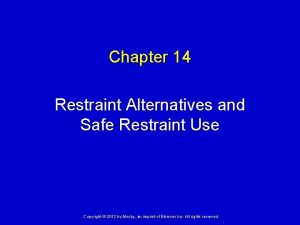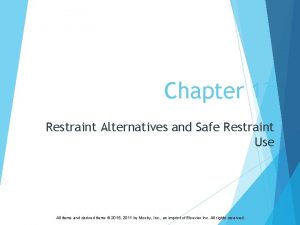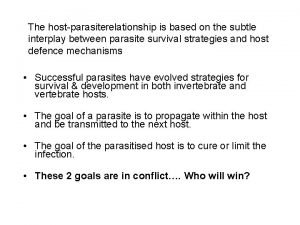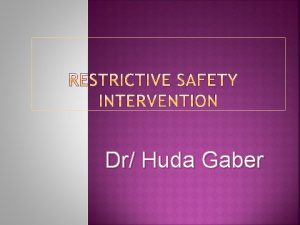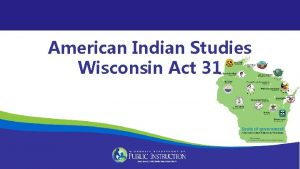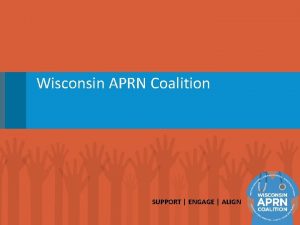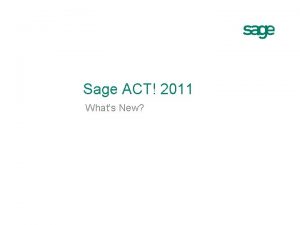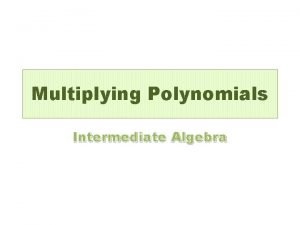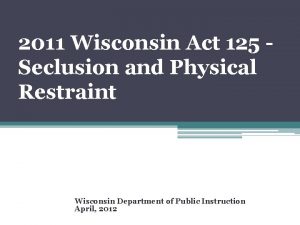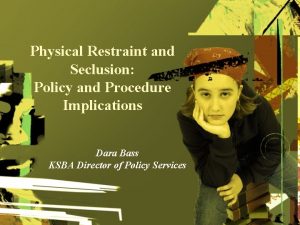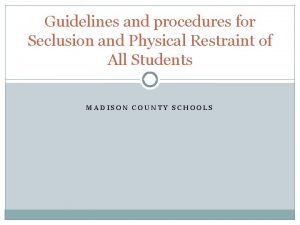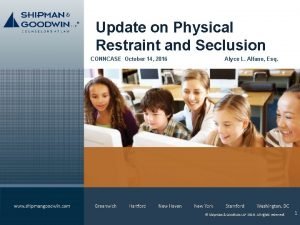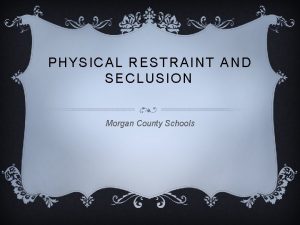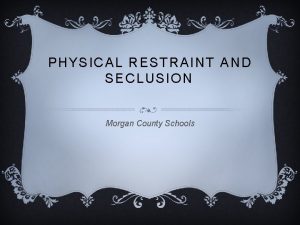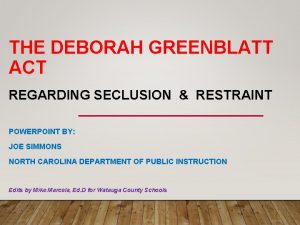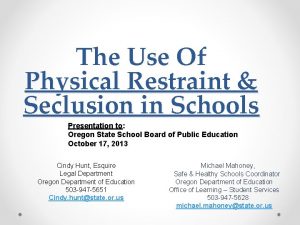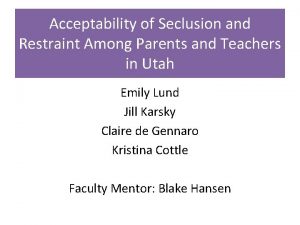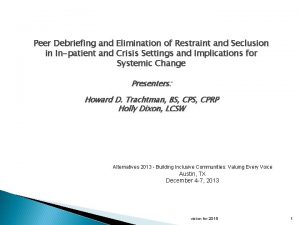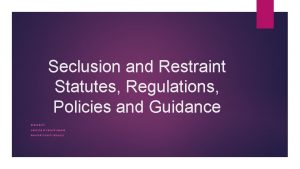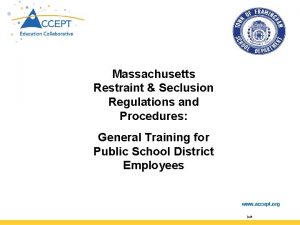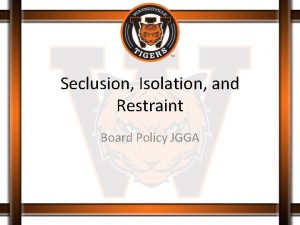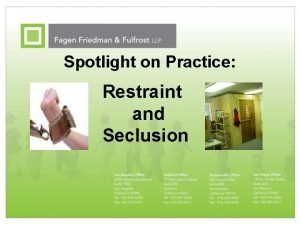2011 Act 125 Seclusion and Physical Restraint Wisconsin















- Slides: 15

2011 Act 125 Seclusion and Physical Restraint Wisconsin Department of Public Instruction’s 2017 State Superintendent’s Conference on Special Education and Pupil Services Leadership Issues

Context • According to the Office of Civil Rights (OCR), students with disabilities served by IDEA are restrained and secluded at higher rates than students without disabilities. • IDEA protected students represent 12% of students enrolled in U. S. public schools, but represent 64% of students involved in seclusion and/or restraint incidents. (2013 -14) • According to OCR, a school district may discriminate against a student on the basis of his/her disability by, • unnecessarily treating a student with a disability and a student without a disability differently • permitting policies, practices, procedures, and/or criteria that negatively and/or disproportionately impact a student on the basis of his/her disability • Denial of FAPE • Law covers all students and public schools, including charter schools.

Seclusion: the involuntary confinement of a pupil, apart from other pupils, in a room or area from which the pupil is physically prevented from leaving. Wis. Stat. 118. 305

Six Conditions for Permissible Use of Seclusion 1. Behavior presents a clear, present, and imminent risk AND it is the least restrictive intervention possible. 2. Staff maintains constant supervision. 3. The room or area is free of objects or fixtures that may injure the student. 4. Student has adequate access to bathroom facilities, water, medication, and regularly scheduled meals. 5. Duration is only as long as necessary to resolve the incident. 6. No locks may be used on the door.

Physical Restraint: a restriction that immobilizes or reduces the ability of a pupil to freely move his or her torso, arms, legs, or head. Wis. Stat. 118. 305

Six Conditions for Permissible Use of Restraint 1. Behavior presents a clear, present, and imminent risk AND it is the least restrictive intervention possible. 2. Ensure that the restraint does not cause or exacerbate a medical situation or condition. 3. The degree of force and the duration of the restraint do not exceed the degree of force and duration that are reasonable and necessary to resolve the incident. 4. Techniques that do not properly protect the student’s head, cause chest compressions (weight on abdomen, diaphragm, etc. ), or that obstruct breathing/circulation should not be used. 5. No corporal punishment. 6. No mechanical or chemical restraints

Mechanical Restraint? • Weighted blankets, vests, seatbelts, adaptive stroller, etc. • Mechanical/adaptive devices used for sensory or support under the direction and oversight of appropriate medical or therapeutic staff are not mechanical restraints. • Adaptive devices are generally permissible if it is used to properly align the body, assist in mobility, and/or assist in maintaining balance • It is an IEP decision as to what will/will not be used • Supports must be identified in the IEP

Training • At least one staff member in each school should receive training. • Staff members who have regular contact with students should be trained on the requirements. • Maintain records • • who was trained when what areas was the individual trained when will the training need to be refreshed • Unforeseen emergency exception

Things to Remember • Student’s ability to communicate should not be restricted. • Seclusion and restraint should only be used to defuse a dangerous situation, protect the student and others from serious bodily injury, and re-establish a safe learning environment. • Seclusion and restraint should never be used for disciplinary reasons. • Verbal and non-compliant behavior usually would not meet the requirements for seclusion and restraint. • The name of the room is less important than how the space is used. • i. e. ‘Quiet room’

Notification and Reporting Requirements • Principal (or a designee) must complete/sign the incident report. • At a minimum, the form should include: • the student’s name • date • time and duration of the restraint/seclusion • description of the incident (including the student’s actions before, during, and after the incident) • the names/titles of the school staff present at the time of the incident • The incident report must be made available within three business days, but it must be completed within two business days of the incident. • Parents must be informed of the incident and the availability of the report within one business day.

Notification and Reporting Requirements • Staff are required to notify parents every time seclusion or restraint occurs. • Each school must report seclusion and restraint data to the school board annually, by September 1 st. • Report must include: • number of incidents of seclusion and restraints for the previous academic year • the total number of students involved in each incident • the number of students with disabilities involved in incidents • Data can be complied into one district wide report but each school’s data must be individually identified.

IEP Should there be a statement in the IEPs that seclusion or restraint may be used? • When an IEP team can reasonably anticipate that seclusion and restraint may be used on a student with a disability, the IEP must include a statement that S&R may be used as an intervention. • However, the IEP must also identify appropriate positive interventions and supports, and any other strategies that will support the student’s behavior. These interventions must be based on the functional behavior assessment.

Common Questions • What happens if parents refuse to have seclusion and restraint language included in their child’s IEP? • Does the IEP team have to meet every time a student is secluded/restrained? • What should staff do after a student without a disability is secluded or restrained for the first time? • Is it okay to adopt a technique that is parent approved? (i. e. the parent has success with a specific technique at home and shares it with the IEP team). • Does the parent need to provide medical documentation to use a mechanical support? • Can a weighted vest/blanket, seatbelt, etc. (mechanical device) be used on a student without a disability to provide additional support? • Is it permissible to use a device on a student (such as a seatbelt) if the student performs tasks (eating, sorting, etc. ) better with it than without? Is it permissible to use a device such as a seatbelt if the student is able to remove it on his/her own? • Are preschools included under the seclusion and restraint laws? • Do seclusion and restraint laws apply to law enforcement/SROs, and if so, how? • Who should/can provide training for restraint techniques?

IDEA Complaint Decisions • 17 -009 • 16 -049 • 16 -051 • 15 -048 • 15 -051 • 15 -057

Resources • Addressing The Use of Seclusion and Physical Restraint in Schools: 2011 Wisconsin Act 125 Requirements FAQ • Sample Report Form • Dear Colleague Letter • U. S. Department of Education Restraint and Seclusion Resource Document Mankah Zama Mitchell School Administration Consultant Mankah. Mitchell@dpi. wi. gov
 Restraint alternatives
Restraint alternatives Restraint alternatives are
Restraint alternatives are Anatomical seclusion
Anatomical seclusion Anatomical seclusion
Anatomical seclusion Anatomical seclusion
Anatomical seclusion What is psychomotor agitation
What is psychomotor agitation Act 31 wisconsin
Act 31 wisconsin Wisconsin aprn modernization act
Wisconsin aprn modernization act Macbeth act 2 summary
Macbeth act 2 summary Sage act 2011
Sage act 2011 Construction act 2011 payment terms
Construction act 2011 payment terms Cone volume ratio
Cone volume ratio A^2+b^2 formula
A^2+b^2 formula Pricing tripod in service marketing
Pricing tripod in service marketing Physical activity and physical fitness assessments grade 9
Physical activity and physical fitness assessments grade 9 200 sayısının 20 fazlası kaçtır
200 sayısının 20 fazlası kaçtır
